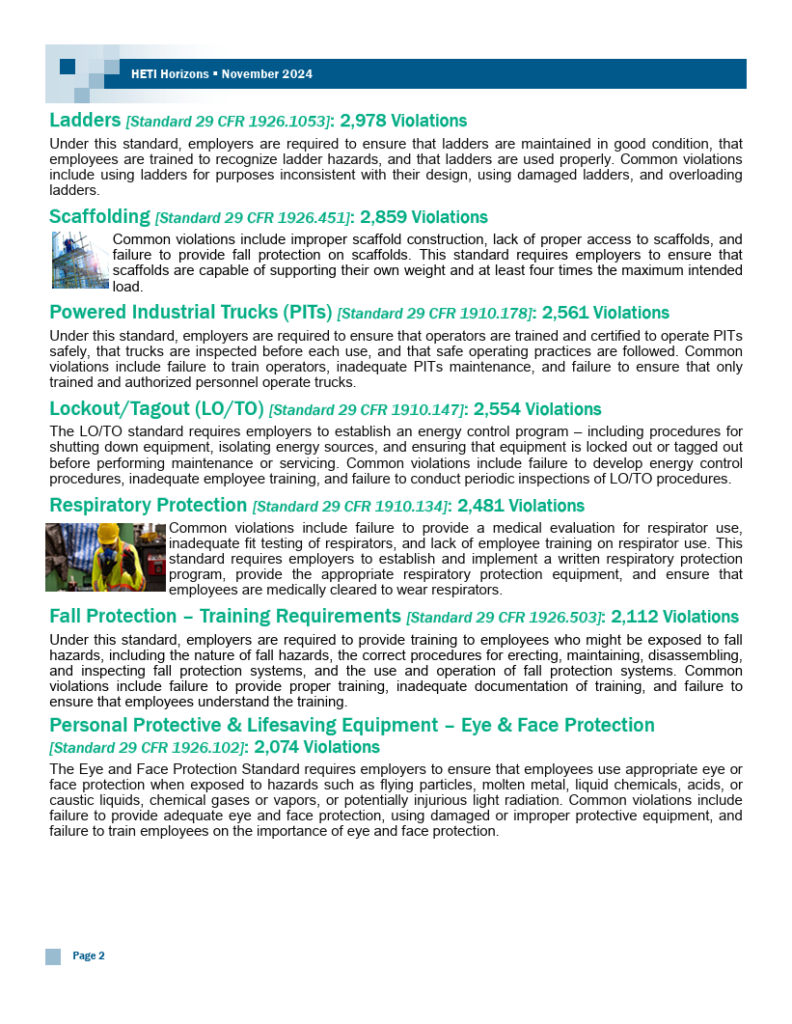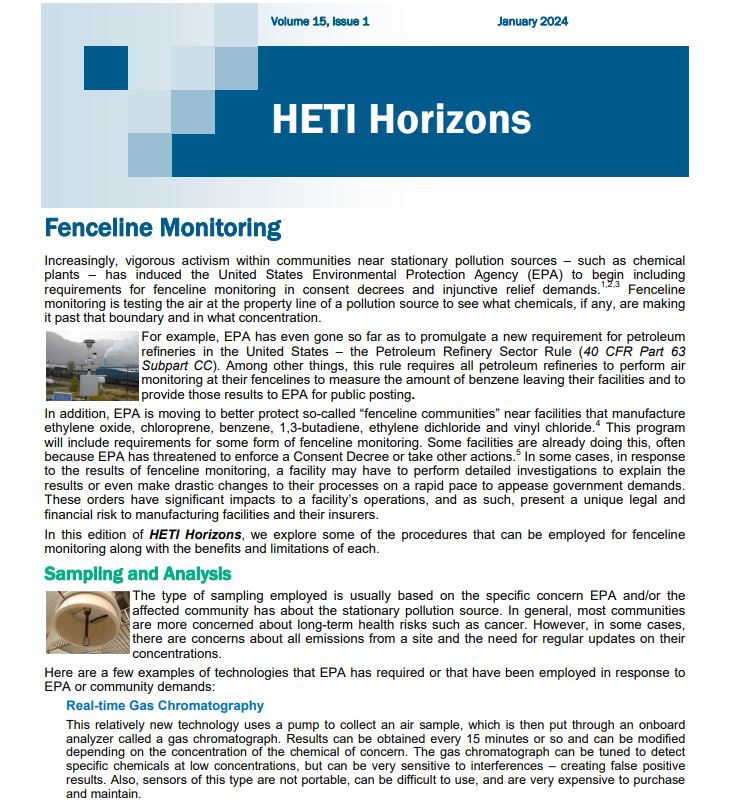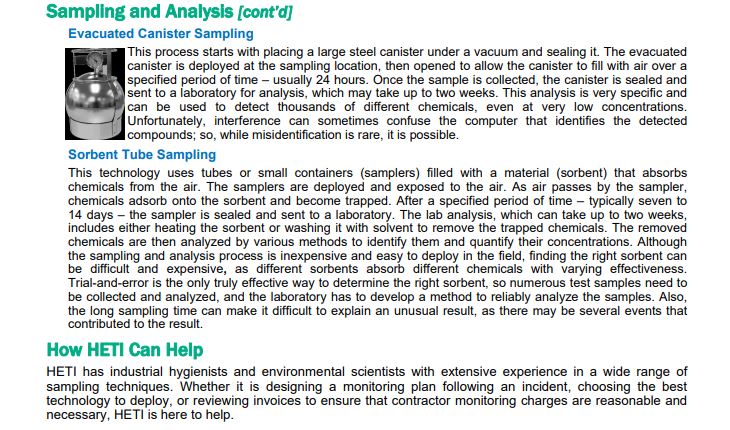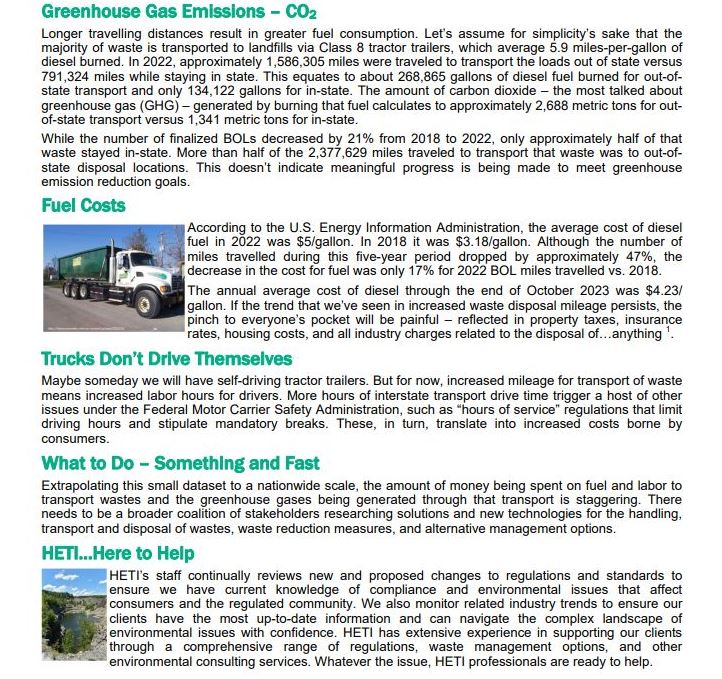


Hydro-Environmental Technologies Inc.
A Full-Service Environmental, Health, Safety, & Risk Management Firm







Environmental response activities conducted within the first few hours following a spill or a release are critical, as they can have significant impact on the extent of damages and the overall cost of cleanup/remediation. Regardless of the magnitude of the event, environmental incident response generally includes four steps: incident/hazard communication, spill control, spill containment, and cleanup/remediation. Successful management and execution of these steps depends on pre-incident planning and preparation.
Incident/Hazard Communication
It is essential that the nature of an environmental incident is quickly and effectively communicated to key personnel as soon as a release or spill is discovered. In cases involving injuries, fire or other catastrophic events, the first call should be to local emergency response services or 911. Releases may also need to be reported to the National Response Center (NRC) and/or appropriate federal/state regulatory agencies.
When a release or spill is initially reported, the following information, at a minimum, should be communicated: location, date, and time that the incident occurred; name and contact information for the responsible party; source and cause of the release/spill; types and quantities of spilled or released materials; medium (e.g., soil, water, air) impacted by the release; and weather conditions. This and other pertinent information are important in assembling and dispatching the appropriate personnel to respond to the incident.
After an incident response team is established, Safety Data Sheets for the released material should be obtained and distributed – so that responding personnel can select appropriate personal protective equipment (PPE) and that other necessary emergency response equipment can be dispatched to the incident site.
During an incident, well-planned and effective communications with the affected community – such as alerts and warnings; directives about sheltering-in-place, evacuation and curfews; information about the response status; etc. – can help ensure public safety, protect property, elicit cooperation, and instill public confidence.
All of these incident/hazard communication activities are often conducted simultaneously.
Spill Control
After the hazards have been assessed and conditions are determined to be safe, it may be possible to take certain actions to control and secure the scene before the incident response team arrives. Whenever possible and appropriate, shutting off potential sources of ignition and/or isolating heat sources could prevent fire; and, if safe, closing a valve, placing a container under the leak, or straightening a tipped container may be a simple action that can reduce the magnitude of the incident. After the incident response team has appeared onsite, if the source of the spill is still leaking and cannot be controlled, it may be necessary to stop the source by transferring the materials into appropriate, safe containers.
Spill Containment
Spill containment includes actions to prevent the spread of released materials. These activities are commonly employed by response team personnel and hazardous waste technicians, and include deployment of neutralizers or absorbent materials – such as pads, pillows and booms – starting at the perimeter and working toward the center of the spill. Particular attention should be paid to pathways leading to environmentally sensitive areas, such as floor drains, water supply and drainage conduits which may need to be plugged or bermed.
Cleanup/Remediation
After the spill has been contained, cleanup/remediation of impacted environmental media can begin. While the cleanup technology implemented at any spill site must be designed for that specific incident, remediation of smaller releases often includes excavation and disposal of impacted soil, while impacted surface water is frequently collected using vacuum trucks. Recovered impacted media is often disposed at approved facilities (landfills, wastewater treatment plants, etc.). As part of remediation activities, a certain amount of restoration, such as soil backfilling, re-paving, and/or re-seeding may be necessary.
Depending on local regulations, follow-up investigations may be necessary to assess potential soil, surface water or groundwater impacts. These investigations are generally not performed by the response team but rather by environmental consultants and specialists.
Pre-Incident Planning Program
Pre-incident planning and preparation is a crucial step in the effective response to environmental incidents. A well-planned response will help minimize environmental damages and liabilities, as well as limit potential business losses.
It takes considerable time and resources to perform a risk assessment, review hazards or threat scenarios, identify and vet external incident response teams, determine regulatory requirements, develop protective actions, develop emergency procedures, and train personnel. Additionally, after response protocols are developed, the plans must be periodically updated to assure that regulatory requirements are satisfied and that the availability and capabilities of incident response vendors are still in place. To further complicate matters, there has been much consolidation in the emergency environmental response industry in recent years. New vendors have entered the arena, while others no longer exist.
For these reasons, many companies opt to engage incident/spill response management consultants that typically maintain working relationships with a network of multi-disciplined response specialists (emergency environmental spill responders, disaster recovery experts, restoration specialists, environmental consultants, industrial hygienists and indoor air quality consultants, and waste management/disposal experts).
When outsourcing the incident/spill management function of the Pre-Incident Planning Program, one should look for the following offerings:
▪ 24/7 spill notification call number
▪ Immediate call back by a spill response project manager
▪ On-scene coordination – fast response times to site with qualified staff
▪ Established relationships with emergency response contractors
▪ Expertise with federal/state/local regulations
▪ Waste profiling and disposal coordination
▪ Regulatory agency liaison
▪ Engineering evaluation cost analysis
▪ Documentation and report preparation
Emergency Response Services from HETI
HETI has 30-plus years of experience providing emergency response services. Through our special emergency response department, supported by a toll-free hotline, we provide full-service capabilities involving all aspects of incident/spill management – including 24-hour, seven-day-a-week intervention to deal with environmental emergencies and to mitigate potential environmental impacts. HETI’s staff is supplanted, as required, by a national network of reputable subcontractors with whom we have established working relationships.
We all have learned behavioral health and safety habits like tooth brushing, putting your seat belt on as soon as you get in the car, or looking both ways before crossing a street. The reward for developing these behavioral habits over the years is your health and safety.
Today, somewhere between 80 to 90% of all work accidents are triggered by unsafe behaviors or human error. Risky behaviors at work increase the likelihood of injury, while safe behaviors promote injury prevention. So, implementing behavioral safety practices in the workplace can help prevent hazardous situations from occurring.
A recent study conducted by Cambridge University and published in the Journal of Organizational Behavior Management as “Behavior-based Safety 2022: Today’s Evidence” found that having a limited number of dedicated observers is more effective than encouraging all employees to participate and that being observed once a month is more useful than more frequent observations.
Take safe driving behavior as an example. One can judge drivers based on how they adjust their vehicle speed and position relative to other drivers, how they maneuver safely if a hazardous situation develops, and how considerate they are while passing other vehicles or changing lanes. Similar to drivers that do not pay attention to road conditions or text while driving, employees can become distracted if they do not focus on their behavioral safety. Their actions could then result in accidents or near misses.
Behavior-Based Safety Programs
There are two categories of unsafe behavior: violations and errors. Violations are deliberate choices made by workers not to follow safety rules, due to carelessness or lack of consequences. Errors are unintentional errors (making mistakes without realizing it) and habitual errors (due to routine or a “we’ve always done it that way” mentality). Note that unintentional errors are not intentional errors made by employees which need to be dealt with by the human resources department.
A Behavior-Based Safety Program informs management and employees regarding general safety issues in the workplace through safety observations gathered from workers’ focus on their own and their colleagues’ daily safety behavior. Safety management personnel know that promoting safe behavior in the workplace is a key element in building and maintaining a positive safety culture within any organization.
Behavior-Based Safety Programs have four key elements:
Observation
Here the observer gathers information about workers’ behavioral habits, analyzes injury history, and identifies how the habits affect the work-related safety challenges for the tasks the workers are performing. The observer categorizes safe and unsafe behaviors in order to find all opportunities for safety improvement. Be aware of the observation bias (Hawthorne effect) where workers being observed change their behavior because they are aware of being watched – significantly impacting their safety behaviors.
Checklists
A behavior-based safety checklist is a direct-observation tool used to recognize safe behavior and eliminate the root cause of unsafe acts. Checklists usually contain the following elements:
> Personal Protective Equipment – like head, eye, hearing, hand, respiratory and foot protection.
> Body Usage and Positioning – commonly including ergonomics and pinch point hazards
> Vehicle &Tools Selection and Inspection
> Travel Paths – which may include identifying the least potential incident incurring route of travel
Feedback
Behavior-Based Safety Programs are actually continuous feedback loops where the workers and observers require response from each other to improve overall safety. By discussing how the employees can perform their jobs safer, the observers learn a little more about the tasks, while at the same time the workers become extra aware of their behavior. Positive feedback is especially encouraged. Once problem areas are identified and agreed upon, it’s crucial to find solutions to reduce or eliminate the safety hazards. Keep in mind that every workplace is unique and that the solutions need to be specially designed for that workplace. There are no one-size-fits-all solutions.
Goals
The goal of the Behavior-Based Safety Program is observing and correcting habits – focusing on preventing safety incidents, not just responding to them. For an average person, it takes a couple of months to break a bad behavioral habit or to form a new good one.
There are several approaches that have kindled urgent success in encouraging safe behaviors in the workplace – such as safety-oriented training, supportive peer guidance and surveillance, developing procedures that workers must follow, and rewarding safe behaviors.
Behavioral Safety Services from HETI
HETI can help clients implement Behavior-Based Safety Programs in the workplace by conducting on-site safety reviews, recording safe and unsafe behaviors, sharing the findings, and providing feedback. A well-implemented Behavior-Based Safety Program can significantly increase productivity levels within a company and raise the work environment morale – by reducing workdays lost due to workplace injuries, workers’ compensation payments, investigations, training of the replacement worker, and product/line damage.
References:
Jim Spigener, Gennifer Lyon & Terry McSween (2022), Behavior-Based Safety 2022: Today’s Evidence, Journal of Organizational Behavior Management, 42:4, 336-359, DOI: 10.1080/01608061.2022.2048943
¨
Microplastics have become ubiquitous in natural and built environments, which has caused concern regarding potential harm to human and aquatic life. Microplastics – plastic particles ranging in size from five millimeters (mm) to one nanometer (nm) – have been found in every ecosystem on the planet from the Antarctic tundra to tropical coral reefs.1
Microplastics are microscopic pieces of plastic that break down from common plastic materials – such as food wrapping, tires, and synthetic fabrics – and end up in our environment. They vary in shape, size and morphology. The majority of these microplastics get washed away by rain, enter watersheds, and eventually end up in marine sediments. Sediments are under almost every water body and are primarily organic and mineral matter. They are important ecosystems and a major sink for contaminants but are often overlooked because they exist below the surface.2
According to one recent article from Remediation Technology “microplastics from tires can account for 30-40% of plastics pollution in the environment.” 4
Environmental Contamination
The plastics are often present in composites with nanomaterials such as carbon nanotubes or graphene oxide that maximize desirable properties like strength, conductivity, and antibacterial activity. Assuming current trends in production and no improvements in waste management, releases of microplastics into the environment may grow to 90 metric tons per year by 2030.5
Microplastics can occur as primary plastics that are introduced into the environment by industrial spills. However, most microplastic environmental contamination comes from the mechanical breakdown of plastic products such as pipes, plastic cups and bottles, carpet, and other plastic consumer and industrial products. These are known as secondary microplastics. Studies suggest that some bottled drinking water may even contain miniscule plastic particles introduced by the container and cap. 6
Health Concerns/Effects
Definitive evidence linking microplastic consumption to human health is currently lacking. However, results from correlative studies in people exposed to high concentrations of microplastics and model animal/cell culture experiments suggest that effects of microplastics could include provoking immune and stress responses and inducing reproductive and developmental toxicity. Further research is required to explore the potential implications of this recent contaminant in our environment in more rigorous clinical studies.7
The accumulation of microplastics worldwide has led to increasing amounts in not only marine life and nature, but also is now highly suspected in humans as well. A study was recently published that claimed microplastics were found within human blood.6
The health concern of microplastics for humans occurs from the ingestion of chemicals used in their manufacture or of pollutants that concentrate on the porous surface of the particles.6 Particles (<150 micrometers) can be ingested by living organisms, migrate through the intestinal wall and reach lymph nodes and other body organs. The primary pathway of human exposure to microplastics has been identified as gastrointestinal ingestion, pulmonary inhalation, and dermal infiltration.
Microplastics may pollute drinking water, bioaccumulate in the food chain, and release toxic chemicals that may cause disease, including certain cancers. They may pose acute toxicity, (sub) chronic toxicity, carcinogenicity, genotoxicity, and developmental toxicity. In addition, microplastics may pose chronic toxicity (cardiovascular toxicity, hepatotoxicity, and neurotoxicity). The toxicity of microplastics primarily depends on the particle size distribution and monomeric composition/characteristics of polymers.8
“Given the variety in plastics, there is no standard or ‘one size fits all’ method for quantifying microplastics in environmental samples. It makes it difficult to compare data and results of various studies when there are hundreds of methods used across the world.” What concerns us is that everywhere we look – arctic, deep-sea trenches, human plasma – we find plastic. The more we look, the more we find,” says Environmental Protection Agency (EPA) chemist Michaela Cashman, Ph.D., the lead author on a recent EPA-led study that developed a new method for identifying microplastics.2
Conclusions
Microplastics have infiltrated every part of the planet. They have been found buried in Antarctic sea ice, within the guts of marine animals inhabiting the deepest ocean trenches, and in drinking water around the world. Plastic pollution has been found on beaches of remote, uninhabited islands and has shown up in sea water samples across the planet. One study estimated that there are around 24.4 trillion microplastic fragments in the upper regions of the world’s oceans. Microplastics are spread widely in soils on land too and can even end up in the food we eat. Unwittingly, we may be consuming tiny fragments of plastic with almost every bite we take.9
EPA and other organizations are actively researching microplastics; however, there is admittedly much more work to be done including determining the short- and long-term effects on human health and the environment.
Additional Resources
HETI’s Certified Industrial Hygienists, Professional Engineers and Environmental Specialists are available to assist clients with a variety of services to help assess and/or characterize the safety and impact of microplastics in their organizations.
References:
1 Microplastics Research | US EPA
2 Making Microplastic Identification More Accessible | US
4 RemediationTechnology@products-bnp.com,
5 Assessing Effects of Nano- and Microplastics in Aquatic Environments | Science Inventory | US EPA
6 Microplastics – Eurofins USA
9 How microplastics are infiltrating the food you eat – BBC Future
